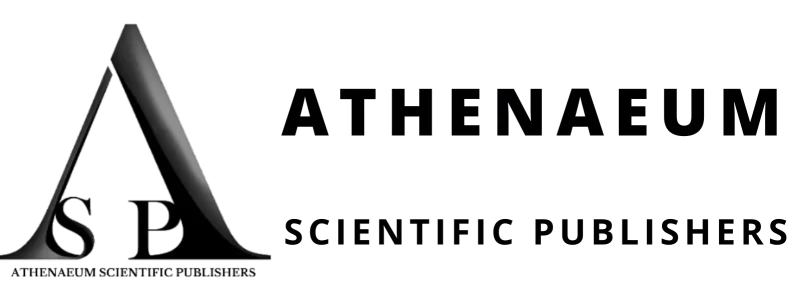Roland Deek1*, Josipa Petric1, Neil Kruger2, Melanie Amarasooriya3, John White4, Gregory I Bain5
1- Medical student, College of Medicine and Public Health, Flinders University, South Australia, Australia
2- Orthopaedic Research Unit, University of Cape Town, Groote Schuur Hospital, Cape Town, South Africa
3- Consultant Orthopaedic Surgeon, Base Hospital Diyatalawa and visiting lecturer, University of Colombo, Sri Lanka
4- Consultant Hand and Upper Limb Surgeon, Department of Orthopaedic and Trauma Surgery, Flinders Medical Centre, Adelaide, South Australia, Australia
5- Consultant Hand and Upper Limb Surgeon, Department of Orthopaedic and Trauma Surgery, Flinders Medical Centre, Adelaide, South Australia, Australia
*Corresponding Author: Roland Deek, College of Medicine and Public Health, Flinders University, Flinders Drive, Bedford Park, 5042, Australia; Email: [email protected]
Published Date: 21-11-2020
Copyright© 2020 by Deek R, et al. All rights reserved. This is an open access article distributed under the terms of the Creative Commons Attribution License, which permits unrestricted use, distribution, and reproduction in any medium, provided the original author and source are credited.
Abstract
Introduction: The wrist is a complex joint, and static imaging techniques may not capture subtle kinematic abnormalities. Four-dimensional (4D) CT presents an alternative method of assessing the dynamic movement of the Transverse Carpal Ligament (TCL). The TCL is important in carpal stability, grip strength, and as a component of the flexor pulley system. The purpose of this study is to determine the dynamic displacement of the TCL attachment points in-vivo through wrist Flexion-Extension (FE) and Radio-Ulnar (RUD) deviation using 4D CT.
Materials and Methods: A normal wrist as was imaged through FE and RUD. Surface rendered models were created from individual carpal bones in each wrist position through the motion arc using 4D CT scans. These bones were tracked using a registration algorithm, and their translations were graphed against the global wrist motion.
Results: During wrist flexion, all TCL attachment points moved proximally and volarly. There was minimal displacement of the attachments in the radioulnar plane. During wrist ulnar to radial deviation, the radial attachment points moved proximally and ulnar attachment points distally. In the radioulnar plane, all attachment points moved radially, except scaphoid, which translated ulnarly. The scapho-pisiform distance showed marked shortening in wrist radial deviation.
Conclusions: This study demonstrates that 4D-CT can be effectively utilized to assess TCL kinematics in-vivo. The TCL is a dynamic structure with distinct movements in all three planes, dependent on the wrist’s direction of movement.
Keywords
Carpal Tunnel; Transverse Carpal Ligament; Wrist; Kinematics
Introduction
The wrist is a complex joint, consisting of many bones and ligamentous structures. Static MRI and CT may not detect dynamic carpal pathology. Fluoroscopy is a commonly used non-invasive method of evaluating major carpal instabilities, however, it is limited by its inability to detect subtle ‘dyskinematics’. More recently, research has shown the utility of Four-Dimensional (4D) CT as a visualization tool for assessing dynamic movements in wrist and other joints.
The use of 4D-CT allows for the visualisation and appreciation of the dynamic motion of various joints. This includes subtle spatial changes up to 0.3 mm, and the ability to visualize four 3D images per second. These 4D-CT scans are currently utilised as an alternative diagnostic modality, particularly for cases with inconclusive findings that may otherwise require invasive procedures such as wrist arthroscopy [1]. The clinical utility of 4D-CT in diagnosing wrist pathologies has been shown by Carr et al., and White et al., [2,3]. However, this technology is still developing in terms of the quantification of carpal bone motion in-vivo. The current study focuses on the utilization of 4D-CT to quantify the motion of the Transverse Carpal Ligament (TCL) attachments in-vivo.
The TCL is the midportion of the Flexor Retinaculum (FR) that has bone-to-bone attachments, forming the volar boundary of the carpal tunnel [4]. Histologically, there are two distinct fibrous structures: a superficial layer continuous with the antebrachial fascia, and a deeper layer composed of strong lamina [5]. This deeper layer, which possesses histological features of a ligament, is the TCL. The TCL inserts into the scaphoid tuberosity and trapezial ridge radially, and the pisiform and hook of hamate ulnarly [6,7]. The largest attachment sites are to the trapezium and hook of hamate, with a characteristically more elongated attachment having a 2:1 ratio of length to width [8]. The attachment sites on the scaphoid and pisiform are smaller and more circular, with a 1:1 ratio of length to width. Approximately two thirds of the thenar and almost half of hypothenar muscles originate here, in addition to receiving some of the distal fibres of palmaris longus [9,10].
The TCL acts as a conduit for the flexor tendons preventing bowstringing and maintaining their position close to the joint axis [11,12]. During tip pinch between the thumb and index finger, the TCL is pulled volarly by the thenar muscles, decreasing the carpal arch width [13]. The TCL is implicated in carpal stability to varying degrees by several authors [14-16]. Transection of the TCL results in a widening of the carpal arch width and angular rotations within the Distal Carpal Row (DCR) and sectioning of the TCL leads to a significant increase in intracarpal mobility a under distraction load [16,17]. TCL insertions are accurately defined on the respective carpal bones, and knowledge of their displacement through wrist range of motion will inform TCL kinematics [8]. The aim of this pilot study is to assess the dynamic displacement of the TCL attachments using 4D-CT, through wrist Flexion-Extension (FE) and Radio-Ulnar (RUD) deviation, in-vivo.
Methods
Patients
Patients undergoing 4D-CT scans for suspected dynamic wrist pathology at our institution are prospectively added to a database and archived (Institutional Review Board number SSA/19/SAC/151). A patient who had a normal concurrent CT, MRI and wrist arthroscopy was identified and the Digital Imaging and Communications in Medicine (DICOM) data extracted for processing.
4D-CT Imaging
The right wrist was imaged on a Siemens Somatom Force Dual source CT scanner in neutral position and ranged through FE and RUD. An initial scout image centred the carpus in the 58.8 mm wide gantry. Each scan sequence was approximately 6 to 12 seconds, scanned at four frames per second. This rotating gantry acquired images with an axial slice thickness of 0.6 mm and a helical sensitivity of 0.23 mm. The scanner output data is archived in raw DICOM format.
Data Processing
The raw DICOM data was transferred to a medical imaging software program, 3D Slicer [18,19]. The imported data is converted to discrete 3D volumes at each acquired time point. These individual volumes form a 3D image sequence consisting of an individual 3D model per acquired time point.
Individual carpal bones of interest (scaphoid, trapezium, hamate, pisiform, radius and 3rd metacarpal) were segmented semi-automatically using intensity thresholding and saved as STL files. The neutral reference frame is defined as the frame where the 3rd metacarpal axis aligns with the long axis of the radius.
An anatomical coordinate system for the radius was defined as described by the International Society of Biomechanics [20]. This was modified, as the scan partially captured the radius within the DICOM dataset, and required further manual correction to achieve a complete 3-dimensional overlap. The anatomical coordinate system of the radius was aligned with the co-ordinate system of the scanner gantry, with a computerized algorithm (Fig. 1). This was to compensate for possible differences in the position and orientation of the radius in the CT-scanner [21].
All the radius models from frame 1 to 12 were then positioned in the same co-ordinate system, using the same algorithm. This was to eliminate the effect of the patient moving the forearm during the scan, ensuring that all movements were measured with respect to the “fixed” radius. Thus, the radius could then be considered a stationary platform to which the carpal bone motions can be referenced.
The translations of each carpal bone were described in relation to the radius coordinate system. The radio-ulnar plane was defined as the X plane, the proximal-distal plane as the Y plane, and the dorso-volar plane as the Z plane (Fig. 1).

Figure 1: Anatomical coordinate system which defines the distal radius. This was aligned to the coordinate system of the gantry, so that X-plane represents radioulnar plane, Y-plane proximal-distal plane and Z-plane dorso-volar plane. From this standardized radius, the relative position of the individual carpal bones was defined. Positive and negative values are represented as follows: X (+) ulnar translation and X (-) radial translation; Y (+) distal and Y (-) proximal; Z (+) volar and Z (-) dorsal.
Tracking
The attachment footprints of the transverse carpal ligament were defined as described by Nanno et al., and marked on the 3D surface rendered models of the scaphoid, trapezium, hamate and pisiform (Fig. 2) [7]. The centre of each footprint was marked with a fiducial marker. A fiducial marker is a specific point marker, applied on to the surface model of the bone. It can be used to track the motion of the point that it has been placed on. The position of the marker then is tracked through the wrist motion using an automated registration algorithm. Precision of the tracking algorithm was assessed with test and re-test repeatability of a Coefficient of Variance (CV) less than 0.01 mm. Accuracy of the technique compared to visual tracking of an anatomical landmark is excellent with a coefficient of variance less than 0.1. The changes in the spatial position of these markers (x, y and z co-ordinates) were obtained from the tracking method and transferred to Microsoft excel 2016 for calculations.

Figure 2: Diagram of the wrist in the neutral position and the transverse carpal ligament attachments, visualized from the volar (A) and distal (B) aspects. The position of the fiducial markers (black dots) were placed as in the centre of the footprint of the TCL attachment, described by Nanno et al. (2015).
Calculations
Radio-ulnar (X-plane), proximo-distal (Y-plane) and volar-dorsal (Z-plane) translations (in millimetres) of each attachment point of the TCL were graphed against the global wrist motion depicted by the angle of 3rd metacarpal [20]. Euclidean distance measurements of both the total distance each attachment point moves, and the distance between the insertion points for the radial and ulnar sided attachments (piso-hamate and scapho-trapezoid) and distal and proximal attachments (scapho-pisiform and trapezio-hamate) were calculated using three-dimensional Pythagoras theory from their respective x, y and z plane co-ordinates. The findings in wrist flexion and extension and radioulnar deviation are outlined below.
Results
Wrist Extension-Flexion
Radio-ulnar Translation
From extension to flexion, trapezium, hamate and pisiform attachment points show minimal radioulnar translations (less than 2 mm). The hamate and pisiform attachments undergo radial translation from extension to neutral (Fig. 3). Then, they ulnarly translate as the wrist transitions from neutral to flexion. The trapezium attachment point and the scaphoid attachment point, however, translate ulnarly throughout the wrist motion (Table 1).

Figure 3: Extension to flexion – translation of the TCL attachments. Shown during wrist extension, neutral, and flexion, from the volar, dorsal, distal, ulnar, and radial views.
Bone | Extension to neutral | Neutral to flexion | Total |
Scaphoid | 11.6 | 6.1 | 16.9 |
Trapezium | 22.4 | 14.3 | 35.1 |
Hamate | 23.4 | 19.0 | 37.5 |
Pisiform | 13.9 | 11.9 | 24.4 |
Table 1: Euclidean distance movement of the TCL attachments.
Proximo-distal Translation
In extension, the distal carpal row attachments (trapezium and hamate) are distal to the proximal row attachments (scaphoid and pisiform). From extension to flexion, all attachments translate proximally (Fig. 4, Table 2). The trapezium attachment translates the most (28.2 mm). This aligns the trapezium and scaphoid attachments in the same transverse plane.

Figure 4: Extension to flexion – proximodistal translation of the TCL attachments. All attachments translate proximally, though the distal attachments (trapezium and hamate) undergo greater translation.
Attachments | Extension to neutral | Neutral to Flexion | Total |
Scapho-trapezial | 2.1 | 0.0 | 2.1 |
Piso-hamate | -2.6 | -0.2 | -2.8 |
Scapho-pisiform | 1.2 | -3.2 | -2.0 |
Trapezio-hamate | -0.4 | -0.2 | -0.5 |
Table 2: Euclidean distance – change in distance between attachments starting in full wrist extension. Negative values represent shortening of this distance.
Volar-dorsal Translation
From extension to flexion, the translation of the distal attachments is much greater compared to the proximal attachments (Table 3). In full extension, the hamate attachment is dorsal to the trapezial attachment: this represents pronation of the DCR. This relationship is maintained from extension to neutral. However, from neutral to flexion, the trapezium attachment approximates the hamate attachment, demonstrating supination of the DCR (Fig. 5). The proximal row attachments maintain their relationship (hamate volar to scaphoid) throughout wrist extension to flexion.

Figure 5: Extension to flexion – volar/dorsal translation of the TCL attachments. The translation of the distal attachments (trapezium and hamate) is much greater compared to the proximal attachments (scaphoid and pisiform).
Bone | Extension to neutral | Neutral to flexion | Total |
Scaphoid | 5.7 | -0.8 | 5.0 |
Trapezium | 17.2 | 3.7 | 20.9 |
Hamate | 22.6 | 6.5 | 29.1 |
Pisiform | 6.4 | -2.0 | 4.4 |
Table 3: Volar/dorsal translation of the TCL attachments (volar is positive (+ve); dorsal is negative (-ve)).
Flexion-extension Euclidean Distance
During wrist extension to flexion, the primary contributor to the Euclidean translation distances of the TCL attachments is proximal translation (Fig. 6). The scaphoid attachment point shows the least Euclidean translation distance (16.9 mm) (Table 3).

Figure 6: Extension to flexion – translation of the scaphoid and pisiform, and their respective attachments. Shown from the volar, dorsal, distal, ulnar, and radial views.
The piso-hamate distance decreases from wrist extension to flexion by 2.8 mm (Table 2). Distances between scapho-pisiform and trapezio-hamate decrease by 2 mm and 0.5 mm, respectively. The scapho-trapezial distance increases by 2.1 mm.
Wrist Ulnar-Radial Deviation
Radio-ulnar Translation
From ulnar deviation to radial deviation, the pisiform, hamate, and trapezium attachments translate radially (Fig. 7 and 8). The radial translation of the hamate attachment is the greatest (11.5 mm) (Table 4). The scaphoid attachment, however, translates ulnarly. The scaphotrapezial attachment relationship is constant from full ulnar deviation to 5◦ ulnar deviation of the wrist, but these points then diverge in this plane to full wrist radial deviation.

Figure 7: Ulnar to radial deviation – radioulnar translation of the TCL attachments. The pisiform, hamate, and trapezium attachments translate radially, while the scaphoid attachment translates ulnarly.

Figure 8: Ulnar to radial deviation – radioulnar translation of the TCL attachments. Shown during UD, neutral, and RD, from the volar, dorsal, distal, ulnar and radial views.
Bone | UD to neutral | Neutral to RD | Total |
Scaphoid | 5.9 | 5.9 | 11.8 |
Trapezium | 4.4 | 8.7 | 12.6 |
Hamate | 4.5 | 10.0 | 14.2 |
Pisiform | 2.9 | 8.3 | 11.1 |
Table 4: Euclidean distance movement of the TCL attachments.
Proximo-distal Translation
From ulnar to radial deviation, the radial attachments (trapezium and scaphoid) translate proximally, whereas the ulnar attachments (hamate and pisiform) translate distally (Fig. 9). The scaphoid attachment translates the most, and the hamate attachment the least (Table 5).

Figure 9: Ulnar to radial deviation – proximal / distal translation of the TCL attachments. The radial attachments (trapezium and scaphoid) translate proximally, whereas the ulnar attachments (hamate and pisiform) translate distally.
Attachment points | UD to neutral | Neutral to RD | Total |
Scapho-trapezial | 0.5 | 1.2 | 1.7 |
Pisio-hamate | 0.2 | -1.0 | -0.8 |
Scapho-pisiform | -3.2 | -2.6 | -5.7 |
Trapezio-hamate | -0.1 | 0.6 | 0.5 |
Table 5: Euclidean distance – change in distance between attachments starting in full ulnar deviation. Negative values represent shortening of this distance.
Volar-dorsal Translation
From ulnar to radial deviation, the scaphoid attachment undergoes the least translation (2.2 mm) in the volar-dorsal plane (Table 6). The pisiform, trapezium and hamate attachments translate 4.8 mm, 2.7 mm and 7.3 mm volarly, respectively.
Bone | UD to neutral | Neutral to RD | Total |
Scaphoid | 1.3 | 1.0 | 2.2 |
Trapezium | 2.0 | 0.7 | 2.7 |
Hamate | 3.0 | 4.3 | 7.3 |
Pisiform | 1.3 | 3.6 | 4.8 |
Table 6: Volar/dorsal translation of the TCL attachments (volar is positive (+ve); dorsal is negative (-ve)).
Radio-ulnar Deviation Euclidean Distance
The proximal attachments move less than the distal attachments (Table 4). The Euclidean distances between the distal, radial and ulnar attachment points all changed by less than 1.7 mm from ulnar to radial deviation (Table 5). In contrast, the proximal (scapho-pisiform) distance decreased by 5.7 mm as the wrist moved into radial deviation, and plateaued at 15◦ of radial deviation (Fig. 10).

Figure 10: Ulnar to radial deviation – Euclidean distance between the attachments. The scapho-pisiform distance decreases by 5.7 mm as the wrist moves into radial deviation.
Discussion
The current study demonstrates that 4D-CT can be effectively utilized to assess wrist kinematics, and more specifically, the kinematics of the TCL. This is the first study assessing kinematics of the TCL using dynamic imaging. In addition to the graphic representation of the dynamic nature of the TCL, we have been able to measure the displacement of individual TCL attachments as the wrist moves through radioulnar deviation and flexion-extension.
There have been previous attempts to quantify carpal bone motion using 4D-CT utilising various techniques, such as the tracking of anatomical landmarks on a 2D videographic output [22]. This technique does not utilise 3D volume rendering technology, and has a higher associated error rate than the technique outlined in this study. More recently, 4D CT has been used in cadaveric studies of the ankle to quantify kinematic changes following ligament sectioning [23]. Similarly, there have been other studies focused on scapholunate instability and calculating angles using 4D-CT [24]. However, the tracking technique utilised has been user-dependent.
This current in-vivo study uses 4D-CT and an automated registration algorithm with excellent accuracy and precision. The results indicate there is a substantial dynamic component to the TCL through the wrist range of motion. This allows the TCL to perform its function as both an adaptive pulley and pressure sensitive conduit through which the median nerve and flexor tendons traverse.
Review of cadaveric images demonstrate that the flexor retinaculum is relatively distal within the construct of the wrist (Fig. 11 and 12). It is clearly distal to the lunocapitate joint and the centre of wrist motion, which is at a point in the capitate distal to the proximal end of this bone by approximately one-quarter of its total length [25]. Therefore, the wrist position is determined at the level of the proximal capitate. The TCL is distal to this, centralising the long finger flexors distal to centre of rotation of the wrist. This increases their lever arm to the centre of the wrist, especially for the thumb flexor.

Figure 11: Cadaveric wrist seen from the volar aspect, with the wrist in 20-degrees extension. Note the carpal tunnel (star) and the TCL attachments are distal to the lunocapitate joint and the space of Poirier (arrow). Radioscaphocapitate ligament (RSCL); Radial (R); Ulnar (U); Pisiform (P), Scaphoid tubercle (S). Image courtesy Dr Amit Gupta.

Figure 12: Cadaveric wrist seen from the proximal aspect. Note the carpus loads through the volar lunate facet. The insertions of the wrist flexors are into the radial and ulnar pillars of the carpal tunnel. That is the FCU into the pisiform (P) and the FCR into the trapezium. These are relatively volar to the carpus, creating a strong moment arm for wrist flexion. In contrast the long finger flexors pass just volar to the lunate, and therefore, have a short moment arm, so have minimal contribution to wrist flexion. With wrist flexion, the TCL prevents the volar bowstringing of the long flexor tendons, Pisiform (P), Triquetrum (Tq), Flexor Carpi Ulnaris (FCU). Image courtesy Dr Amit Gupta.
Wrist Extension-Flexion
Proximo-distal Plane
From wrist extension to flexion, the pisiform attachment point translates proximally, maintaining its position proximal to the hamate throughout the arc of motion, and undergoing minimal radio-ulnar or volar-dorsal translation. The primarily proximal motion of the pisiform likely is due to the guiding force of the Flexor Carpi Ulnaris (FCU) muscle, which inserts into the pisiform and continues as the pisometacarpal and pisohamate ligaments.
The FCU also acts on the pisiform to indirectly influence the position of the TCL, triquetrum and the carpus. As the FCU tightens, the TCL becomes taut, thereby making it a more effective pulley. FCU contraction also causes the pisiform to wedge the triquetrum onto the volar hamate. This is reinforced by the hypothenar muscle, which also inserts into the pisiform and pisohamate ligament.
This pisiform motion has been proposed as an explanation for the degenerative pattern in the piso-triquetral joint, which occurs most frequently in the distal, distal-radial, and radial aspect of the pisiform and triquetrum [26,27]. This contrasts with the trapezio-scaphoid attachment relationship, which remained constant, with both attachments ending in the same proximo-distal position in full wrist flexion.
Volar-dorsal Plane
Intracarpal motion within the Distal Carpal Row (DCR) is minimal [21,28]. We observed that in full wrist extension, the DCR is pronated. However, in wrist flexion, the distal carpal row supinates, bringing the DCR TCL attachments neutral to each other in this plane. Similarly, in full wrist flexion, the scaphoid and pisiform attachment points are neutral to each other in the volar-dorsal plane, although lying more dorsally. All attachment points are thus in the same proximo-distal position in full wrist flexion, making the TCL perpendicular to the radius such that it acts as a perpendicular pulley for the flexor tendons.
From wrist extension to flexion, the distal TCL attachments (hamate and trapezium) undergo greater translation in all planes of movement when compared to the proximal attachments (scaphoid and pisiform). Movements at both the radiocarpal and mid-carpal joints, which contribute substantially to the wrist arcs, are responsible for this greater amount of translation [29].
Wrist Ulnar-Radial Deviation
Radio-ulnar Plane
From wrist ulnar to radial deviation, all TCL attachment points, other than the scaphoid, translate radially. There is more translation in the arc from neutral to radial deviation than from ulnar deviation to neutral. All attachment points undergo minimal motion in all planes from maximal ulnar deviation to 5◦-10◦ of ulnar deviation. This supports that ulnar deviation of the wrist is the position of power and stability, as the attachment points, and hence the distal and proximal carpal rows, are static and stable relative to one another [30,31].
From 5◦-10◦ of ulnar deviation, the scaphotrapezial relationship changes, with the trapezium attachment translating radially, and the scaphoid attachment translating ulnarly. This ulnar translation of the scaphoid attachment, coupled with the radial translation of the pisiform attachment in full wrist radial deviation, decreases the scapho-pisiform component of the TCL by 5.7 mm, thereby relaxing it. Additionally, the scaphoid flexes, with its TCL attachment approximating the pisiform in the dorso-volar plane. This allows the volar displacement of carpal tunnel contents, as the carpal tunnel narrows in radial deviation. Narrowing of the carpal arch width has been shown to increase carpal arch height and area, and is suggested as a mechanism to reduce compression of the median nerve [32]. In contrast to the scapho-pisiform component, the other borders of the TCL undergo very little change in their lengths in either wrist flexion-extension or radial-ulnar deviation. These findings demonstrate a change in the shape of the ligament during radial deviation, with the proximal component of the TCL effectively bowing. This may be partly explained by the unique out-of-plane motion of the scaphoid, the dynamic nature of the pisiform observed, and the forces exerted by the flexor tendons.
This pilot study included a mechanically normal wrist as defined by clinical and radiological investigations. Although the generalisability of this study is limited by patient numbers, it has successfully evaluated the validity of a novel approach for capturing the dynamic nature of the TCL, in-vivo. Future studies should utilise the approach outlined in this pilot study, in conjunction with larger participant numbers, to gain a greater appreciation for variations in both normal and abnormal wrist kinematics.
Conclusion
The present study must be regarded as a preliminary investigation of the utilisation of 4D-CT in assessing TCL kinematics in-vivo. We have demonstrated that the TCL is a dynamic structure with distinct movements in all three planes, dependent on the wrist’s direction of movement. Additionally, it accommodates to wrist position to optimise its function as both a pulley and a conduit for the flexor tendons and median nerve.
Acknowledgments
The authors would like to thank Mrs. Kimberley Bryant, of the department of Orthopaedic and Trauma Surgery, Flinders Medical Centre, for her contributions to the development of this study.
References
- Demehri S, Hafezi-Nejad N, Morelli JN, Thakur U, Lifchez SD, Means KR, et al. Scapholunate kinematics of asymptomatic wrists in comparison with symptomatic contralateral wrists using four-dimensional CT examinations: initial clinical experience. Skeletal Radiol. 2016;45(4):437-46.
- Carr R, MacLean S, Slavotinek J, Bain GI. Four-dimensional computed tomography scanning for dynamic wrist disorders: prospective analysis and recommendations for clinical utility. J Wrist Surg. 2019;8(2):161.
- White J, Couzens G, Jeffery C. The use of 4D-CT in assessing wrist kinematics and pathology: a narrative review. Bone Joint J. 2019;101(11):1325-30.
- Brooks JJ, Schiller JR, Allen SD, Akelman E. Biomechanical and anatomical consequences of carpal tunnel release. Clin Biomech. 2003;18(8):685-93.
- Stecco C, Macchi V, Lancerotto L, Tiengo C, Porzionato A, De Caro R. Comparison of transverse carpal ligament and flexor retinaculum terminology for the wrist. J Hand Surg Am. 2010;35(5):746-53.
- Li ZM, Marquardt TL, Evans PJ, Seitz Jr WH. Biomechanical role of the transverse carpal ligament in carpal tunnel compliance. J Hand Surg Am. 2014;3(4):227.
- Nanno M, Sawaizumi T, Kodera N, Tomori Y, Takai S. Three-dimensional analysis of the attachment and path of the transverse carpal ligament. J Nippon Med Sch. 2015;82(3):130-5.
- Manley M, Boardman M, Goitz RJ. The carpal insertions of the transverse carpal ligament. J Hand Surg Am. 2013;38(4):729-32.
- Georgiev GP, Iliev AA, Dimitrova IN, Kotov GN, Malinova LG, Landzhov BV. Palmaris longus muscle variations: clinical significance and proposal of new classifications. Folia Med. 2017;59(3):289-97.
- Kung J, Budoff JE, Wei ML, Gharbaoui I, Luo ZP. The origins of the thenar and hypothenar muscles. J Hand Surg Br. 2005;30(5):475-6.
- Brett AW, Oliver ML, Agur AM, Edwards AM, Gordon KD. Quantification of the transverse carpal ligament elastic properties by sex and region. Clin Biomech. 2014;29(6):601-6.
- Doyle JR. Palmar and digital flexor tendon pulleys. Clin Orthop Relat Res. 2001;383:84-96.
- Shen ZL, Li ZM. Biomechanical interaction between the transverse carpal ligament and the thenar muscles. J Appl Physiol. 2013;114(2):225-9.
- Fisk GR. The influence of the transverse carpal ligament (flexor retinaculum) on carpal stability. Ann Chir Main. 1984;3(4):297-9.
- Garcia-Elias M, An KN, Cooney III WP, Linscheid RL, Chao EY. Stability of the transverse carpal arch: an experimental study. J Hand Surg Am. 1989;14(2):277-82.
- Vanhees M, Verstreken F, van Riet R. What does the transverse carpal ligament contribute to carpal stability? J Wrist Surg Am. 2015;4(1):31.
- Gabra JN, Domalain M, Li ZM. Movement of the distal carpal row during narrowing and widening of the carpal arch width. J Biomech Eng. 2012;134(10).
- Pates JA, Hatab MR, McIntire DD, Cunningham FG, Twickler DM. Determining uterine blood flow in pregnancy with magnetic resonance imaging. Mag Reson Imaging. 2010;28(4):507-10.
- (2012). http://www.slicer.org / [Last accessed on November 15, 2020].
- Wu G, Van der Helm FC, Veeger HD, Makhsous M, Van Roy P, Anglin C, et al. ISB recommendation on definitions of joint coordinate systems of various joints for the reporting of human joint motion-Part II: shoulder, elbow, wrist and hand. J Biomech. 2005;38(5):981-92.
- Tominaga M, Caterina MJ, Malmberg AB, Rosen TA, Gilbert H, Skinner K, et al. The cloned capsaicin receptor integrates multiple pain-producing stimuli. Neuron. 1998;21(3):531-43.
- Garcia-Elias M, Alomar Serrallach X, Monill Serra J. Dart-throwing motion in patients with scapholunate instability: a dynamic four-dimensional computed tomography study. J Hand Surg Eur. 2014;39(4):346-52.
- Buzzatti L, Keelson B, Apperloo J, Scheerlinck T, Baeyens JP, Van Gompel G, et al. Four-dimensional CT as a valid approach to detect and quantify kinematic changes after selective ankle ligament sectioning. Sci Rep. 2019;9(1):1-9.
- Rauch A, Arab WA, Dap F, Dautel G, Blum A, Gondim Teixeira PA. Four-dimensional CT analysis of wrist kinematics during radioulnar deviation. Radiol. 2018;289(3):750-8.
- Bronzino JD, Peterson DR, editors. Biomedical signals, imaging and informatics. CRC Press. 2014.
- Kofman KE, Schuurman AH, Mulder MC, Verlinde SA, Gierman LM, van Diest PJ, et al. The pisotriquetral joint: osteoarthritis and enthesopathy. J Hand Microsurg. 2014;6(1):18-25.
- Yamaguchi S, Viegas SF, Patterson RM. Anatomic study of the pisotriquetral joint: ligament anatomy and cartilagenous change. J Hand Surg Am. 1998;23(4):600-6.
- De Lange A, Kauer JM, Huiskes R. Kinematic bihavior of the human wrist joint: a roentgen-stereophotogrammetic analysis. J Orthop Res. 1985;3:56-64.
- Stoesser H, Padmore CE, Nishiwaki M, Gammon B, Langohr GD, Johnson JA. Biomechanical evaluation of carpal kinematics during simulated wrist motion. J Wrist Surg Am. 2017;6(2):113.
- O’Driscoll SW, Horii E, Ness R, Cahalan TD, Richards RR, An KN. The relationship between wrist position, grasp size, and grip strength. J Hand Surg Am. 199;17(1):169-77.
- Pryce JC. The wrist position between neutral and ulnar deviation that facilitates the maximum power grip strength. J Biomech. 1980;13(6):505-11.
- Li ZM, Gabra JN, Marquardt TL, Kim DH. Narrowing carpal arch width to increase cross-sectional area of carpal tunnel-a cadaveric study. Clin Biomech. 2013;28(4):402-7.
Article Type
Research Article
Publication History
Received Date: 22-10-2020
Accepted Date: 14-11-2020
Published Date: 21-11-2020
Copyright© 2020 by Deek R, et al. All rights reserved. This is an open access article distributed under the terms of the Creative Commons Attribution License, which permits unrestricted use, distribution, and reproduction in any medium, provided the original author and source are credited.
Citation: Deek R, et al. Four-dimensional CT assessment of the transverse carpal ligament attachments-A pilot study. J Ortho Sci Res. 2020;1(1):1-19.
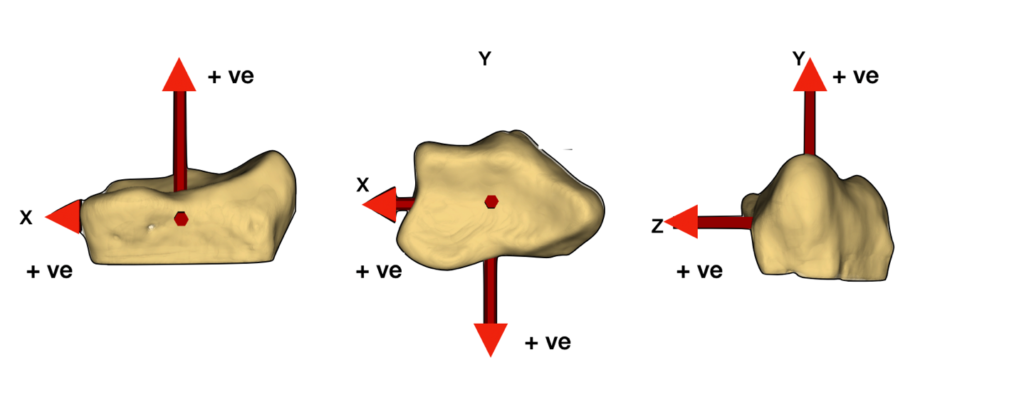
Figure 1: Anatomical coordinate system which defines the distal radius. This was aligned to the coordinate system of the gantry, so that X-plane represents radioulnar plane, Y-plane proximal-distal plane and Z-plane dorso-volar plane. From this standardized radius, the relative position of the individual carpal bones was defined. Positive and negative values are represented as follows: X (+) ulnar translation and X (-) radial translation; Y (+) distal and Y (-) proximal; Z (+) volar and Z (-) dorsal.

Figure 2: Diagram of the wrist in the neutral position and the transverse carpal ligament attachments, visualized from the volar (A) and distal (B) aspects. The position of the fiducial markers (black dots) were placed as in the centre of the footprint of the TCL attachment, described by Nanno et al. (2015).
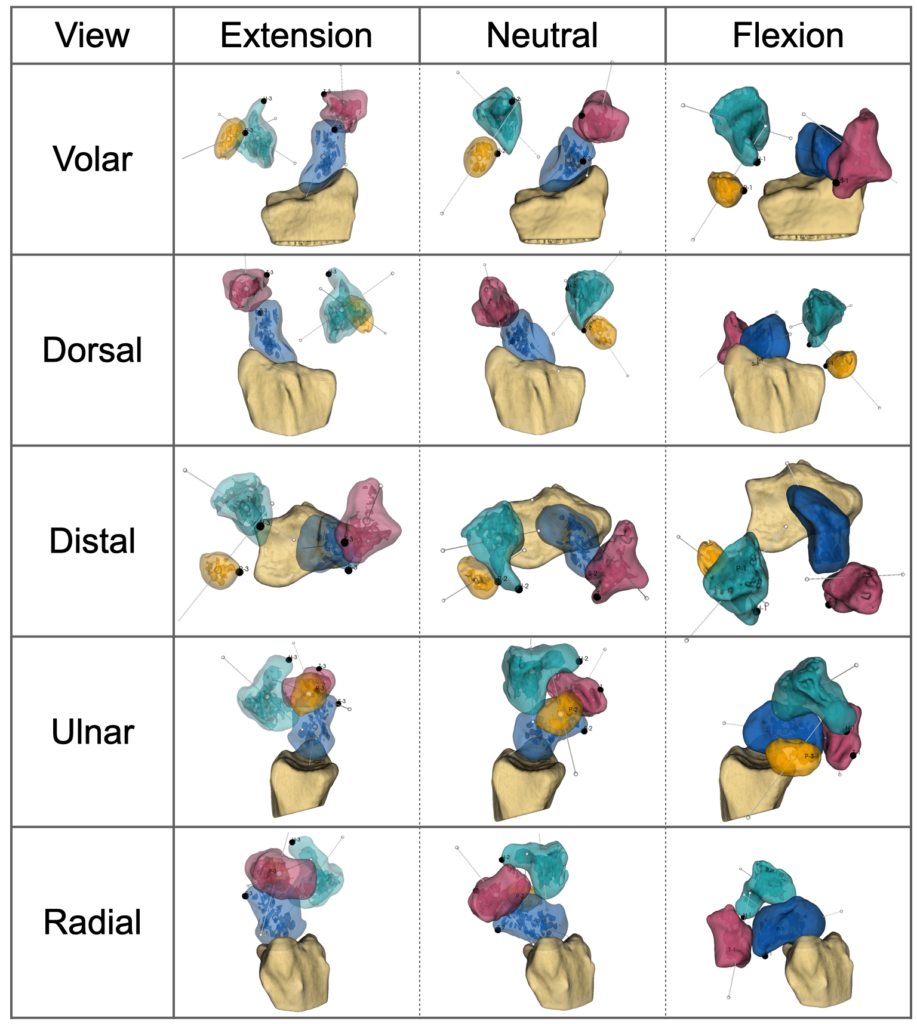
Figure 3: Extension to flexion – translation of the TCL attachments. Shown during wrist extension, neutral, and flexion, from the volar, dorsal, distal, ulnar, and radial views.
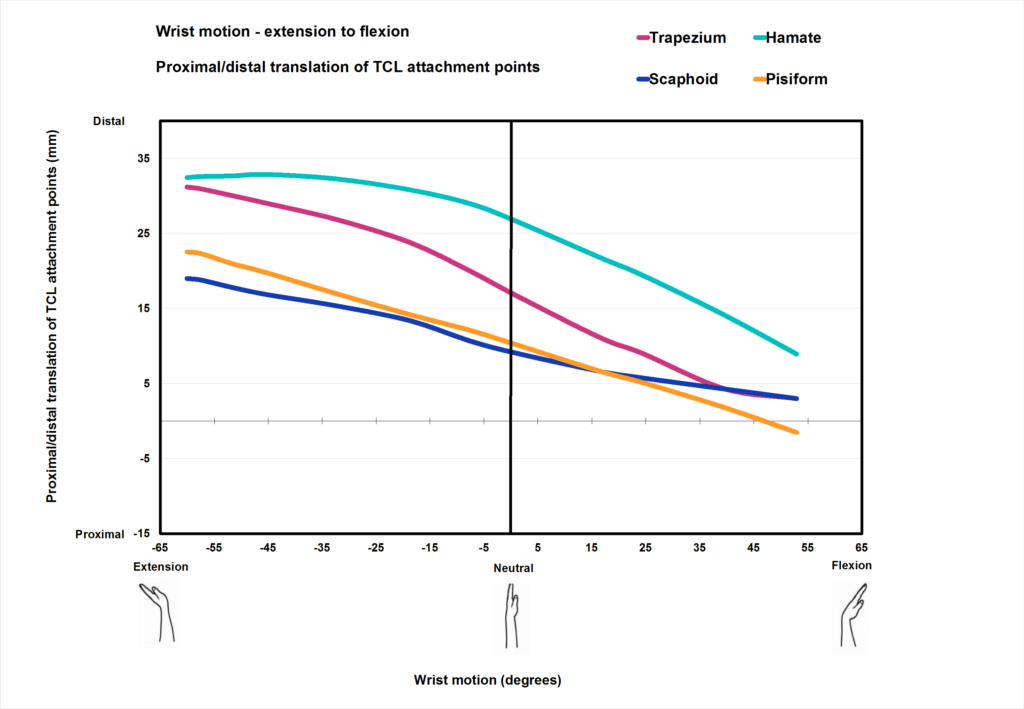
Figure 4: Extension to flexion – proximodistal translation of the TCL attachments. All attachments translate proximally, though the distal attachments (trapezium and hamate) undergo greater translation.
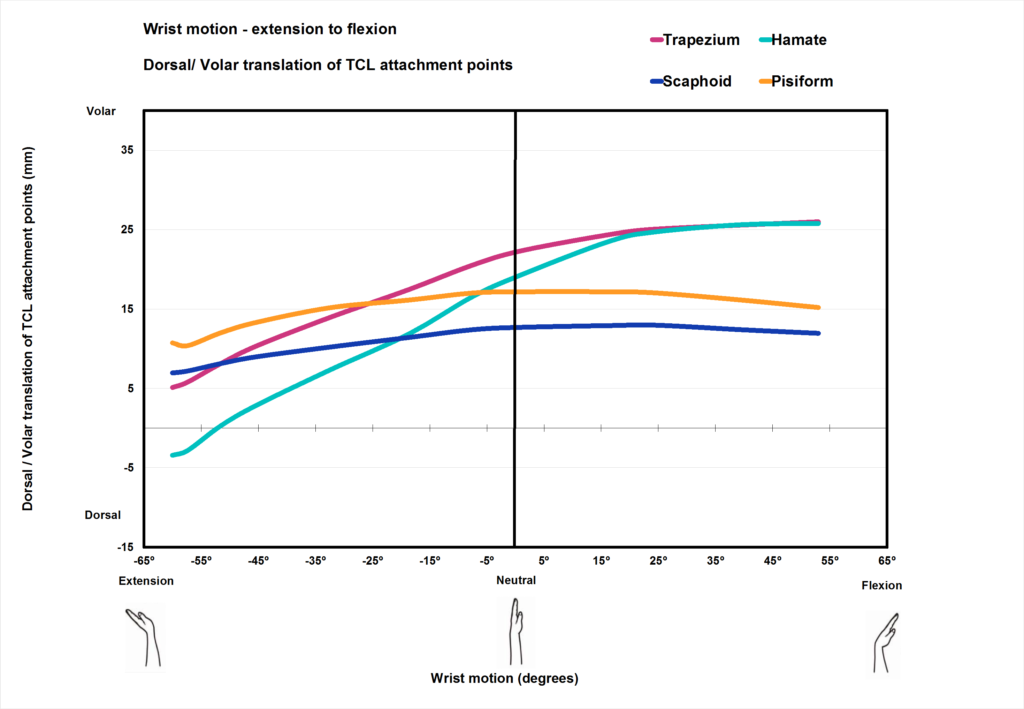
Figure 5: Extension to flexion – volar/dorsal translation of the TCL attachments. The translation of the distal attachments (trapezium and hamate) is much greater compared to the proximal attachments (scaphoid and pisiform).
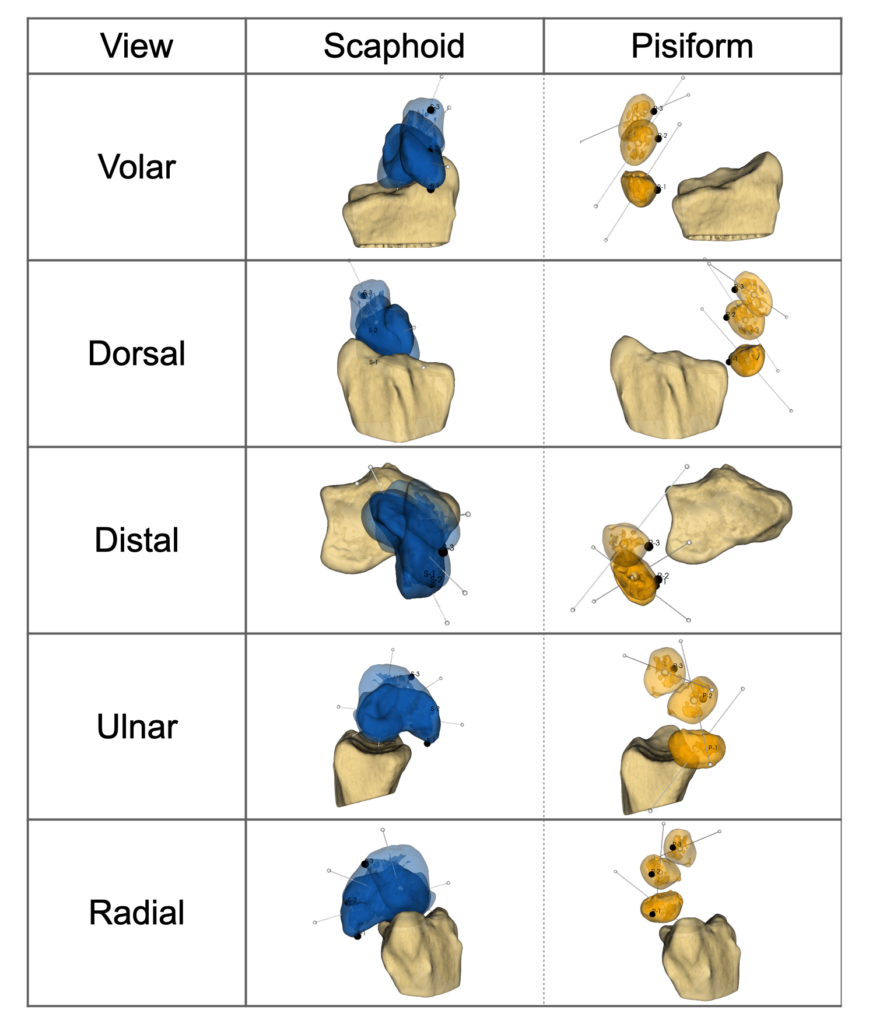
Figure 6: Extension to flexion – translation of the scaphoid and pisiform, and their respective attachments. Shown from the volar, dorsal, distal, ulnar, and radial views.

Figure 7: Ulnar to radial deviation – radioulnar translation of the TCL attachments. The pisiform, hamate, and trapezium attachments translate radially, while the scaphoid attachment translates ulnarly.
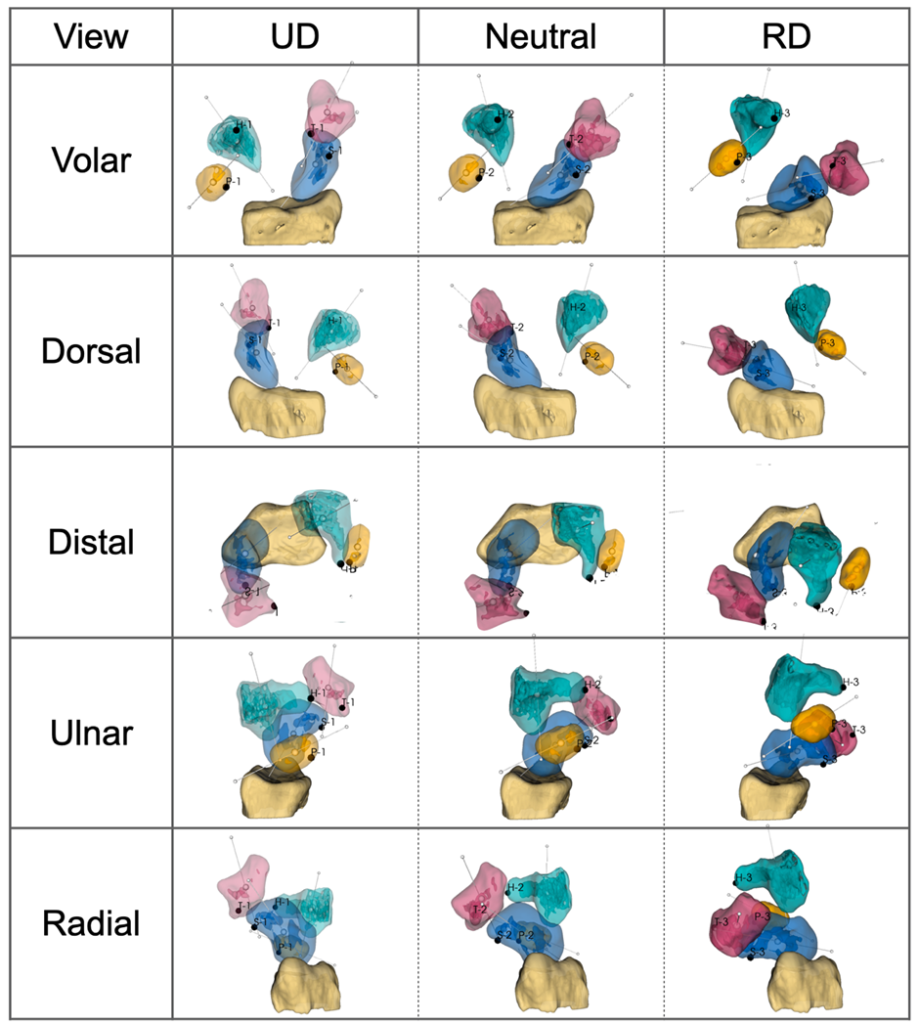
Figure 8: Ulnar to radial deviation – radioulnar translation of the TCL attachments. Shown during UD, neutral, and RD, from the volar, dorsal, distal, ulnar and radial views.

Figure 9: Ulnar to radial deviation – proximal / distal translation of the TCL attachments. The radial attachments (trapezium and scaphoid) translate proximally, whereas the ulnar attachments (hamate and pisiform) translate distally.
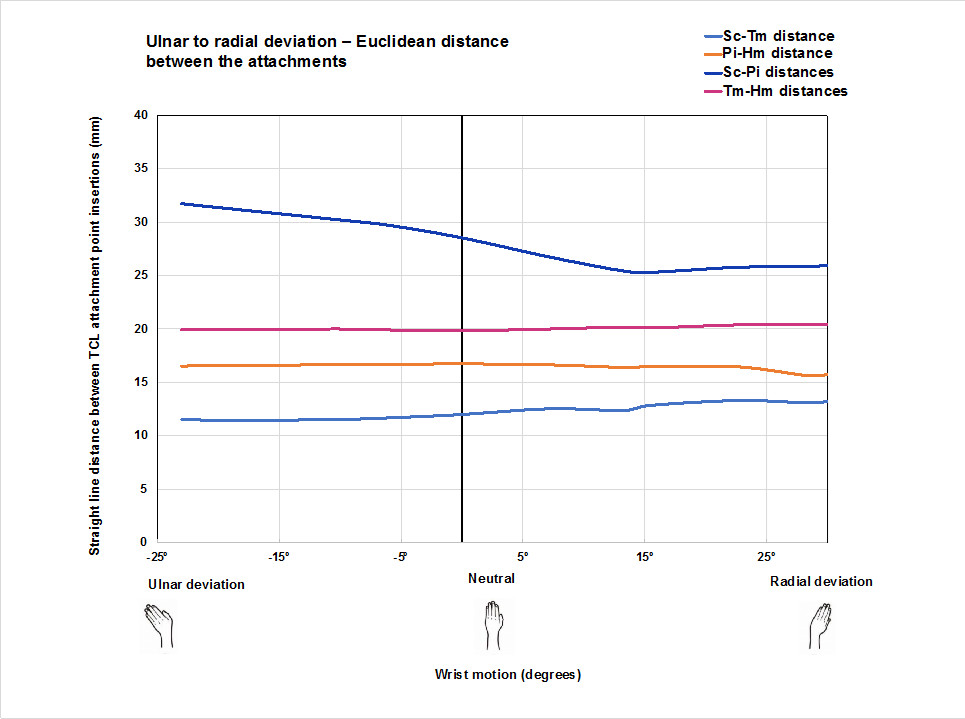
Figure 10: Ulnar to radial deviation – Euclidean distance between the attachments. The scapho-pisiform distance decreases by 5.7 mm as the wrist moves into radial deviation.

Figure 11: Cadaveric wrist seen from the volar aspect, with the wrist in 20-degrees extension. Note the carpal tunnel (star) and the TCL attachments are distal to the lunocapitate joint and the space of Poirier (arrow). Radioscaphocapitate ligament (RSCL); Radial (R); Ulnar (U); Pisiform (P), Scaphoid tubercle (S). Image courtesy Dr Amit Gupta.

Figure 12: Cadaveric wrist seen from the proximal aspect. Note the carpus loads through the volar lunate facet. The insertions of the wrist flexors are into the radial and ulnar pillars of the carpal tunnel. That is the FCU into the pisiform (P) and the FCR into the trapezium. These are relatively volar to the carpus, creating a strong moment arm for wrist flexion. In contrast the long finger flexors pass just volar to the lunate, and therefore, have a short moment arm, so have minimal contribution to wrist flexion. With wrist flexion, the TCL prevents the volar bowstringing of the long flexor tendons, Pisiform (P), Triquetrum (Tq), Flexor Carpi Ulnaris (FCU). Image courtesy Dr Amit Gupta.
Bone | Extension to neutral | Neutral to flexion | Total |
Scaphoid | 11.6 | 6.1 | 16.9 |
Trapezium | 22.4 | 14.3 | 35.1 |
Hamate | 23.4 | 19.0 | 37.5 |
Pisiform | 13.9 | 11.9 | 24.4 |
Table 1: Euclidean distance movement of the TCL attachments.
Attachments | Extension to neutral | Neutral to Flexion | Total |
Scapho-trapezial | 2.1 | 0.0 | 2.1 |
Piso-hamate | -2.6 | -0.2 | -2.8 |
Scapho-pisiform | 1.2 | -3.2 | -2.0 |
Trapezio-hamate | -0.4 | -0.2 | -0.5 |
Table 2: Euclidean distance – change in distance between attachments starting in full wrist extension. Negative values represent shortening of this distance.
Bone | Extension to neutral | Neutral to flexion | Total |
Scaphoid | 5.7 | -0.8 | 5.0 |
Trapezium | 17.2 | 3.7 | 20.9 |
Hamate | 22.6 | 6.5 | 29.1 |
Pisiform | 6.4 | -2.0 | 4.4 |
Table 3: Volar/dorsal translation of the TCL attachments (volar is positive (+ve); dorsal is negative (-ve)).
Bone | UD to neutral | Neutral to RD | Total |
Scaphoid | 5.9 | 5.9 | 11.8 |
Trapezium | 4.4 | 8.7 | 12.6 |
Hamate | 4.5 | 10.0 | 14.2 |
Pisiform | 2.9 | 8.3 | 11.1 |
Table 4: Euclidean distance movement of the TCL attachments.
Attachment points | UD to neutral | Neutral to RD | Total |
Scapho-trapezial | 0.5 | 1.2 | 1.7 |
Pisio-hamate | 0.2 | -1.0 | -0.8 |
Scapho-pisiform | -3.2 | -2.6 | -5.7 |
Trapezio-hamate | -0.1 | 0.6 | 0.5 |
Table 5: Euclidean distance – change in distance between attachments starting in full ulnar deviation. Negative values represent shortening of this distance.
Bone | UD to neutral | Neutral to RD | Total |
Scaphoid | 1.3 | 1.0 | 2.2 |
Trapezium | 2.0 | 0.7 | 2.7 |
Hamate | 3.0 | 4.3 | 7.3 |
Pisiform | 1.3 | 3.6 | 4.8 |
Table 6: Volar/dorsal translation of the TCL attachments (volar is positive (+ve); dorsal is negative (-ve)).
